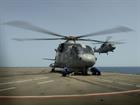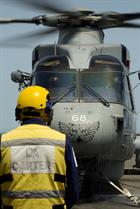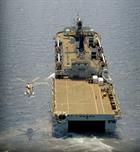CULDROSE MERLIN’S JOIN HMS BULWARK RESCUE MISSION
Merlin helicopters from Royal Naval Air Station Culdrose have began scouring hundreds of square miles of the Central Mediterranean as the Royal Navy’s humanitarian mission moves up a gear.
Hot on the heels of HMS Bulwark’s recent rescue of over 100 migrants from a makeshift rubber dinghy, 814Naval Air Squadron’s Merlin’s are scanning large swathes of theMediterranean Seaon the lookout for people in peril.
Having completed a 1,000-mile journey across Europe from their West Cornwall base the three Merlins from the “Flying Tigers” are acting as Bulwark’s ‘eyes in the sky’, while the ship herself co-ordinates theUKmission, together with Italian Navy and Coast Guard. Operating from Sigonella Naval Air Station nearCataniain easternSicily, the Merlin Mk2 aircraft will use Bulwark as a ‘lilypad’- a floating service station in the middle of theMediterraneanbetween the Libyan and Sicilian coastlines.
“HMS Bulwark is essential to the mission,” explains Commander Stu Finn, 814’s Commanding Officer. “I can extend my range out over the sea, see further, search for longer and report what I find back to the ship to co-ordinate the operation.”
In addition to providing fuel, the amphibious assault ship can launch her large landing craft – manned by Royal Marines and Royal Navy medics and packed with extra lifejackets, food and medical supplies – to conduct searches and be ready to rescue survivors identified by the Merlins.
The Flying Tigers have deployed 82 sailors – 20 aircrew, 62 specialist engineers, technicians and support personnel – for the mission. In theory, the helicopters can search an area almost the size of Englandand Scotlandcombined on lengthy missions that could last up to three hours at a time. Locating small boats in the middle of the ocean is, said pilot Lieutenant Morgan Jones, “a mission the Merlin is particularly good at doing”. He added: “We have done a lot of this sort of work in the past. Our crews are swept up, keen and looking forward to the challenges ahead.”
Once on patrol, the observer and aircrewman who operate the Merlin’s complex computer and sensor systems should be able to detect even small craft several dozen miles from the helicopter. “Our radar was designed to find periscopes which are small and only appear for a matter of seconds, so it should be able to detect small, slowly-moving boats,” says Commander Finn. If that makes the mission sound easy, it is not. On each flight, the helicopter will scan hundreds of square miles of water. The crew wear special immersion suits, lifejackets, and flying helmets; it’s hot, cramped and physically and mentally demanding.
The busy flying schedule will place heavy demands on the team of engineers and technicians the squadron has brought out from Culdrose. “It is already above 30°C by day in Sicily and my team will be working around the clock to do what we have to,” says Warrant Officer 1st Class David Smith, 814’s senior maintenance rating. “It will be hard work, but the boys and girls are used to it – and they’re used to working in challenging environments. The Merlin is a very complex aircraft, but my engineers are highly-trained and can deal with any maintenance asked of them.”
Should the Merlins encounter a stricken vessel, it will be their job to co-ordinate the rescue on the surface, using Bulwark’s landing craft to collect survivors, but the aircrew can intervene and winch around a dozen people to safety if necessary. Says Commander Finn: “This is something we are looking forward to; it’s a real-world situation, doing something for the good of others.”




